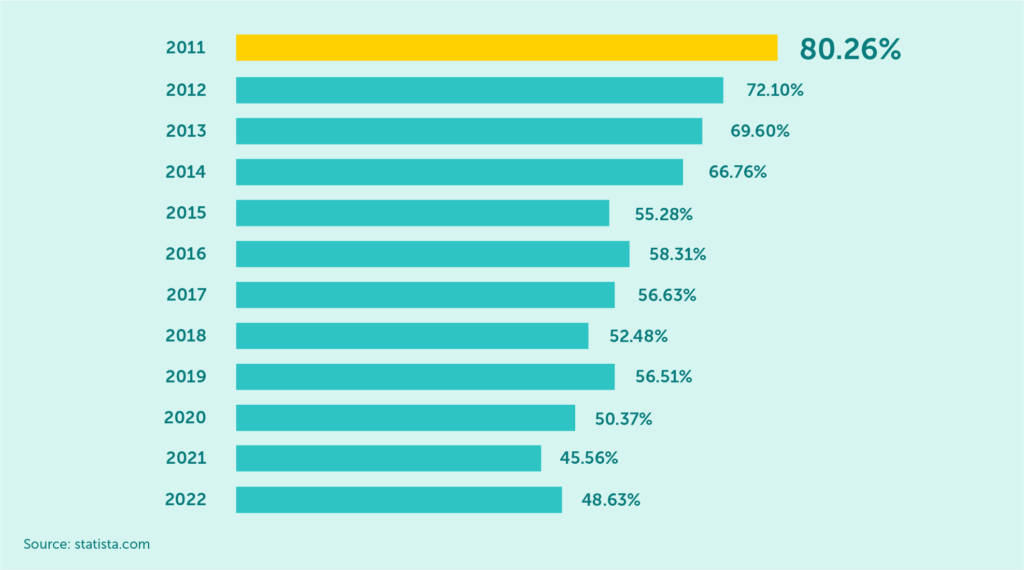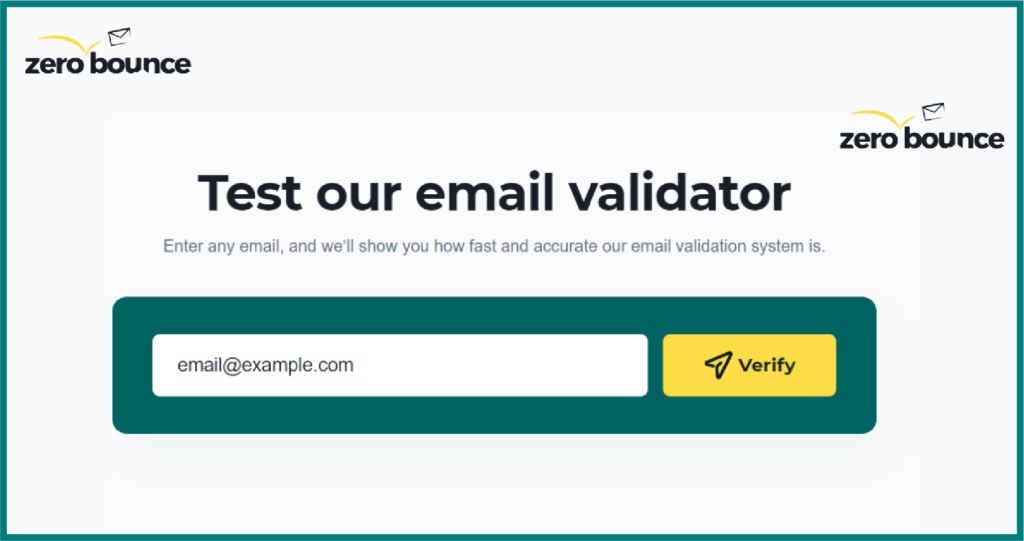Spam Traps are email addresses used by ISPs, various spam-fighting organizations, and Blacklist administrators to identify and monitor the mailings of senders who do not follow good mailing practices when it comes to verifying their contact databases. The aim of their use is to reduce the amount of spam that reaches our mailboxes every day.

Global spam volume as percentage of total e-mail traffic from 2011 to 2022
There are many types of Spam Traps. Most of the time, Spam Traps are email addresses that have been inactive for a long. They can also be recycled email addresses that were once active but are no longer in use, or they can be newly created addresses that have never been used before. In all cases, however, a Spam Trap set up with the intention of catching senders who do not properly verify their contact lists.
If your mailing list contains these types of email addresses, it may mean you are not taking proper care of its hygiene. This can result in your messages being flagged as spam and your IP address being blacklisted. In the worst case, it can even lead to your email service provider shutting down your account.
Using EmailLabs, you can avoid falling into such a trap, as our system has a built-in Spam Trap address filter. When you send a message to an address on our internal, regularly updated list, the sending will be automatically blocked, and the message will receive a “dropped” status. It is important to note that our tool is not designed to clean old contact databases or to find Spam Trap addresses, so such addresses will not be marked in any additional way. To maintain the high deliverability of emails, always send them only to verified and up-to-date recipients.
That’s why it’s important to be aware of what spam traps are and how to avoid them.
Read on to learn more.
Maximize your email deliverability and security with EmailLabs!
When talking about Spam Traps, it is impossible not to mention a particular type of trap – the Honeypot. In cyber security, this term refers to a strategy that relies on the use of appropriately crafted methods (in this case, email addresses) to detect unauthorized processing and reveal the perpetrator.
Such Spam Traps are particularly troublesome for spammers because ISPs or anti-spam organizations do not wait until an address is in the subscriber’s database and someone accidentally sends an email to it.
These addresses are deliberately promoted and made public directly on websites or embedded in their code. Web scraping bots are able to find such addresses and collect them into their database.
Once emails start reaching the mailbox, the active spammer can be located, blocked, and reported to the relevant organization fighting spam.
This Spam Trap can therefore be compared to a pot of honey exposed to the sun – all you have to do is wait patiently, and the insects will be tempted to fly to it themselves.
We usually only become aware that Spam Traps may be present on our mailing list when the delivery rate starts to drop, and we have checked out other potential causes of this phenomenon.
Identifying specific Spam Trap email addresses is not easy – such information is not publicly available, as it would counter the purpose of their existence – spammers would easily exclude them. However, there are several ways to find potential Spam Traps – the key is to track engagement.
A recipient who doesn’t open your emails for several months, doesn’t complete orders, doesn’t use the password reminder, and doesn’t get in touch with you themselves (technical requests/complaints, etc.) could be a Spam Trap (or soon become one).
To be sure, you can segment your contact group and implement a reactivating campaign only for unengaged recipients. If your emails still do not get opened, remove such addresses from your mailing list. Even if they are not Spam Traps, the lack of any response can mean one thing – the recipients are not interested in receiving any correspondence from you.
There are also a number of paid tools available on the Internet that allow you to check for Spam Traps in your mailing list – some of the more popular ones are, for example, ZeroBounce or Email List Verify. You can upload your contact database to these platforms, and they will analyze it for you.

ZeroBounce – email address verification tool
“Spam Traps are an issue that every email marketer needs to be aware of. They can be detrimental to your sending reputation and completely damage the performance of your campaign,”
– says Brian Minick, COO of email validation platform ZeroBounce.“It’s important you are always checking to see if spam traps live on your list. While in theory a good sender would not have them, we’ve seen examples of even the best senders having them added to their newsletter sign-ups maliciously. You never know if they are lurking on your list as, in many cases, they appear to be just a normal looking email address. They’re also being created every day and new ones can appear. It’s critical you get these off and never send to them.
A good validation service such as ZeroBounce can ensure we help get them off your list.”
Fortunately, there are several ways to avoid Spam Traps. The most important thing is to verify the quality of your contact database on an ongoing basis. Some of the foolproof methods you can use to achieve this include the following:
By following these simple rules, you will protect your emailing campaigns against the risk of being trapped by a Spam Trap.
Maximize your email deliverability and security with EmailLabs!
What consequences you face when sending messages to spam trap addresses depends on the type of trap you get ‘caught in.’ If you make a single mailing to invalid addresses with a typo, there should be no reputational impact as long as it involves, for example, registering and sending a double opt-in message (to confirm enrolment), which will shut down further attempts to communicate with the same recipient.
However, multiple mailings to spam trap email addresses (especially a pristine spam trap) can have significant negative consequences – such as a weakening sender reputation, being blacklisted by RBLs, and a decrease in deliverability rates.
The fight against spam is constant. Every day, our inboxes are flooded with emails we do not want.
So let’s remember that Spam Traps are not intended to make it difficult for legitimate senders to carry out their mailings – those who take proper care of the hygiene of their mailing list and send out campaigns only to contacts interested in receiving emails from them, have nothing to fear.
Spam Trap email addresses are allies in the fight against spammers who block visibility in the mailbox for your messages – looking at them this way, you may find them a useful tool.
Gmail has announced significant changes in the requirements for email senders to maintain a good reputation and proper classification of messages in user inboxes starting from February 1, 2024....
Vercom S.A. public joint-stock company to which the EmailLabs project belongs, has been assessed and certified to be compliant with the ISO/IEC 27001 and ISO/IEC 27018 standards. The Vercoms’...
The increasing number of phishing attacks each year, and the projection that this trend will continue to escalate, aren’t likely to astonish anyone. This can be attributed, in part,...
Out of all the things that can go wrong when sending out marketing emails, having your emails end up in the recipient’s spam folder is arguably the most dreaded...
Email Authentication, Security
DMARC is an email authentication protocol that is designed to give domain owners the ability to protect their domain from unauthorized use, commonly known as email spoofing. Spoofing occurs...
With the emergence of the Covid-19 pandemic, many brands have been challenged to adapt in a short period to the changed reality and new consumer attitudes. That meant reorganizing...
Google and Yahoo's Requirements
2024 marks a turning point in the fast-paced world of email deliverability, as this is the year when Google and Yahoo updated their sender requirements. With the enforcement period...
Best practices, Email Marketing
B2B email marketing – it’s a term you’ve likely heard before, but what does it really entail? And, more importantly, how can it be done effectively? In this article,...
Deliverability, Sending Reputation
Email sender reputation is one of the most important factors that can determine whether your emails reach the intended recipient or not. So, what is the email sender reputation,...
Google and Yahoo's Requirements
2024 marks a turning point in the fast-paced world of email deliverability, as this is the year when Google and Yahoo updated their sender requirements. With the enforcement period...
Best practices, Email Marketing
B2B email marketing – it’s a term you’ve likely heard before, but what does it really entail? And, more importantly, how can it be done effectively? In this article,...
Deliverability, Sending Reputation
Email sender reputation is one of the most important factors that can determine whether your emails reach the intended recipient or not. So, what is the email sender reputation,...
Email Authentication, Sending Reputation
In the realm of email, sender authorization is a powerful tool wielded by local and global providers like Gmail, Yahoo, and AOL to combat spam. Additionally, as an authenticated...
As an integral part of your email infrastructure, SMTP and SMTP port numbers are not just for tech whizzes – they’re important for anyone using email. You’ve likely heard...
Ever wondered why you can’t attach a movie to an email? Or why won’t that PowerPoint presentation just send? It all comes down to the maximum size of email...
One of the most dire situations a business can face is unauthorized access to its company network. This breach can lead to the theft of valuable intellectual property and...
The Simple Mail Transfer Protocol (SMTP) holds significant importance in the realm of email communication. As a vital component of mail servers, SMTP takes charge of sending, receiving, and...
The significance of email protection and data security is growing exponentially in today’s digital world, with StartTLS emerging as a key player in this arena. As an encryption protocol...